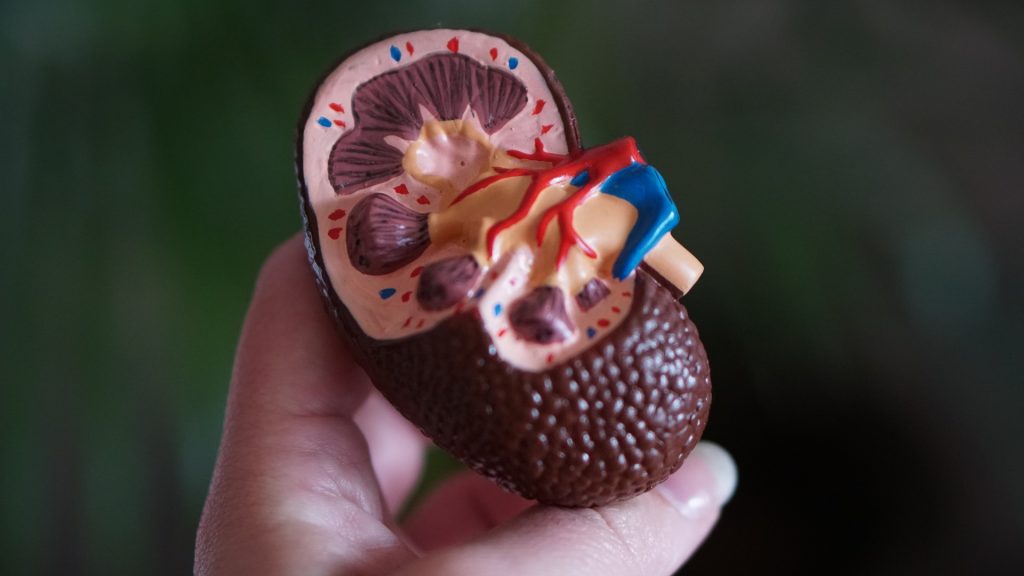34 All-Important Kidney Disease Statistics for 2024

Most people are born with two functioning kidneys. These organs are vital, meaning we can’t survive without at least one of them. What makes these organs this important is that they filter excess fluid and waste from the body. Astoundingly, healthy kidneys filter about 30 gallons of blood daily to get rid of the excess liquid and the waste it contains.
That said, according to the kidney disease statistics, many people can be at risk of developing a complicated health condition. Keep reading to find out the most critical data about kidney stones, chronic kidney disease (CKD), organ donation, and more. We’ve collected the most important stats and facts about kidney disease and answered some of the most frequently asked questions.
10 Most Worrying Kidney Disease Statistics for 2024
- In England, chronic kidney disease (CKD) costs £1.5 billion a year, which is more than lung, colon, skin, and breast cancer combined.
- Worldwide, the CKD prevalence is about 13.4%.
- 38% of people over the age of 65 have CKD.
- 15% of women and 12% of men experience CKD.
- In India, one in ten people suffers from CKD.
- One in three US adults faces the danger of developing CKD, according to kidney disease statistics.
- COVID-19 causes kidney damage, as shown by 30% of patients in China and New York.
- There are around 101,000 Americans on the waiting list for a kidney.
- Over 240 people on dialysis die every day.
- People with obesity are twice as likely to experience kidney failure.
Interesting Facts About the Kidney
This section uncovers some impressive facts and stats about the kidneys, like the first time they were ever mentioned, their appearance in the Bible, the costs associated with kidney disease, and much more. Read on to find out more about the topic.
1. The kidney is the size of a cell phone and weighs four–six ounces.
(DM Clinical Research)
If there’s something we know well, that’s our cell phones, since we use them 24/7. Kidney fun facts reveal that the average kidney is the size of a cell phone so that you can picture it right away. As for its weight, it’s four–six ounces. Although the kidney accounts for only 0.5% of the body’s weight, it gets more blood than other organs, except for the liver.
2. One kidney is smaller than the other.
(Mental Floss)
The kidney fun facts don’t end there. By now, you might know that kidneys are positioned in the lower back, under the rib cage, but what you might not know is that they are usually lopsided. What’s more, one kidney is smaller—the right one, and it is located a little lower than the left one, making room for the liver.
3. Every day our kidneys remove half a gallon of waste and extra liquid from our blood.
(American Kidney Fund)
No one can underestimate the importance of our kidneys as they work hard to clean our blood. However, facts about the kidney report that when the kidneys don’t work properly, waste and water remain in the body. They then return to our blood system, causing problems with lungs, bones, heart, blood, and so on.
4. Kidney stones were mentioned for the first time around 5,000 years ago.
(Mental Floss)
The historical facts about kidney stones report that Mesopotamian medical texts discussed this painful experience alongside the interventions. Kidney stones are even mentioned in the Hippocratic Oath, urging physicians to “not use the knife, not even on sufferers from stone.” That aside, in ancient Greece and India, surgeons tried removing kidney stones as far back as the 7th century BCE, facts about kidney stones reveal.
5. Kidneys are cited over 30 times in the Bible.
(Mental Floss)
Believe it or not, the kidneys are mentioned over 30 times in the Bible; that’s more frequently than the heart, which is rarely mentioned. According to Garabed Eknoyan, a professor at Baylor College of Medicine, assigning symbolic meaning to organs wasn’t uncommon in ancient Middle Eastern texts.
6. The period from the 16th to 18th centuries was the prime time for self-taught surgeons.
(Mental Floss)
One of the most infamous of them was Frère Jacques Beaulieu. He was the pioneer in lateral perineal lithotomy. According to the kidney stone facts, he did more than 5,000 lithotomies, and most of them were deadly. He was finally banned from doing that monstrous procedure in 1698 after 25 of his 60 patients died.
Now, what was the abovementioned surgery all about? The 17th-century lithotomy was the process of making an incision in the perineum, inserting a cutting instrument into the bladder, cutting up the stone, and then extracting the pieces with the instrument or surgeon’s fingers.
7. In England, CKD costs £1.5 billion a year—more than lung, colon, skin, and breast cancer combined.
(HSJ) (National Kidney Foundation)
Treating chronic kidney disease is costly. Chronic kidney disease statistics disclose that CKD affects one in ten British adults, costing the NHS £1.5 billion a year. As unbelievable as it may sound, the chronic kidney disease expenses exceed the combined costs of colon, skin, lung, and breast cancer.
8. Over 80% of those receiving kidney failure treatment have access to universal health care.
(National Kidney Foundation)
Most of them also come from affluent countries with large populations of older people. Then again, statistics on kidney disease predict that the number of kidney failure cases will show a disproportionate increase in developing countries, where the number of older people is on the rise.
Kidney Disease Statistics for the United States
A great number of US citizens fight this battle, and many of the people with kidney problems aren’t aware of having them, since they don’t experience any symptoms. This section will equip you with everything you need to know about kidney disease in the US.
9. Statistics on the prevalence of chronic kidney disease report that 37 million Americans have it.
(American Kidney Fund)
Interestingly, not everyone is aware of having the condition because they may experience no symptoms in the early stages. While some kidney problems are only temporary, others can be an early sign of chronic kidney disease (CKD).
10. Over 661,000 Americans have kidney failure, as kidney disease stats confirm.
(NIH) (Prevea)
Kidney disease appears when a person’s kidneys are too damaged to process waste and excess liquids from the body. In this way, the waste accumulates in the body and causes other health issues. For instance, kidney disease increases the chance of having a stroke or a heart attack. Diabetes, high blood pressure, and a family history of kidney disease also increase a person’s chances of developing kidney disease.
11. 11% of men and 6% of women in the US have kidney stones at least once in their lives.
(NIH) (Organic Aromas)
According to kidney disease statistics, 11% of men and 6% of women in America will have kidney stones at least once. Kidney stones are hard deposits that are made of minerals. These stones are formed in our kidneys. While small kidney stones may pass through the urinary tract unnoticed, the larger ones may cause some damage if they aren’t treated by a medical professional. Surprisingly, essential oils (lemon, lemongrass, lavender, helichrysum, and others) are believed to reduce kidney stones. Check out our list of the best essential oils for additional guidance.
12. 15% of US adults have chronic kidney disease, based on chronic kidney disease statistics of 2019.
(CDC)
15% of the US adult population suffers from CKD, which is more than one in seven adults. Very often, kidney disease symptoms don’t show until the disease has progressed. Consequently, hydronephrosis and chronic kidney disease may develop over time—mostly over a span of a few years.
13. About 500,000 people in the United States have polycystic kidney disease.
(Medline Plus)
Polycystic kidney disease occurs when there are numerous water-filled cysts in the kidneys. If the number of cysts is too big, the kidneys can suffer some damage. That is to say, the growth of cysts can slowly replace much of the kidneys and cause kidney failure. Polycystic kidney disease facts suggest that approximately 500,000 Americans have this condition.
14. In the US, one in two people with CKD who aren’t on dialysis, are unaware of their condition.
(CDC)
Interestingly, the most compelling evidence shows most people with CKD, namely nine in ten adults in the US, don’t know they have it. What’s more, one in two people who have very low kidney function, but aren’t on dialysis, are unaware of having chronic kidney disease.
15. In the case of kidney failure, the facts remark that its treatment uses 6.7% of Medicare’s budget.
(National Kidney Foundation)
The treatment for CKD exceeds $48 billion each year. At the same time, other countries have even greater expenses. For example, in the next ten years, China will be hit with $558 billion in losses attributed to heart disease and kidney disease death and the disabilities caused by them.
16. Kidney dialysis facts report that every year Medicare spends $90,000 per patient on hemodialysis.
(UCSF)
Medicare coverage is available for everyone who needs dialysis or kidney transplantation to stay alive. Namely, Medicare spends $90,000 per patient on hemodialysis. This cost accumulates to $28 billion every year in the United States alone.
Prevalence of Chronic Kidney Disease
[visualizer id=”96770″]
You must be wondering how many people have chronic kidney disease, how often they get it, and whether it’s more common in women or men. Some answers might come as a surprise to you, so let’s read on and gather some new information on this issue.
17. 38% of people over the age of 65 have chronic kidney disease.
(CDC)
CKD is most likely to happen in people older than 65—38%. As for other age groups, it’s 13% of people between 45 and 64 and only 7% of people aged 18–44. According to chronic kidney disease prevalence by age, people over the age of 65 are more prone to this disease than others. Nevertheless, we should all be cautious and try not to overlook the signs.
18. Worldwide, the CKD prevalence is about 13.4%.
(Pub Med) (Oxford Academic)
The global estimated CKD prevalence is between 11.7% and 15.1%. To be more specific, that’s around 13.4%, or 850 million people suffering from chronic kidney disease worldwide, as per chronic kidney disease statistics worldwide for 2020. Furthermore, there are 4.902–7.083 million patients with end-stage kidney disease who need renal replacement therapy.
19. 15% of women experience chronic kidney disease, compared to 12% of men.
(CDC)
Generally speaking, chronic kidney disease is more frequent in women than men. Kidney disease statistics reveal that 15% of women have it, opposed to 12% of men. Another critical point is that adults with CKD have a higher risk of early death compared to their peers who don’t have CKD.
20. In India, one in ten people has CKD.
(Narayana Health)
In India, chronic kidney disease is a severe health issue. To put it into perspective, one in ten people have some form of CKD, according to chronic kidney disease statistics for India in 2019. That said, kidney disease hasn’t received proper public attention. As a result, India will probably face a costly health crisis in the forthcoming years.
21. Men over the age of 50 are more likely to have bladder stones.
(Cleveland Clinic)
Bladder stones and kidney stones are often viewed as the same, but they are not. Facts about kidney disease state that bladder stones form when minerals from the urine crystalize and clump up in the bladder. Generally, bladder stones might form when the bladder isn’t completely emptied.
As always, it’s good to know the symptoms: difficulty urinating, pain in the lower abdomen, pain when urinating, frequent urination, blood in the urine, and cloudy or abnormally dark urine. As mentioned before, men over the age of 50 are more prone to developing bladder stones.
22. There’s a 30% to 50% chance that more stones will form in the next five years following the first one.
(Mental Floss)
Kidney stone statistics suggest that just having a kidney stone puts you at 30%–50% risk of having another. Reducing sodium—the one found in deli meats, packaged soups, and processed foods—may help you lower that risk.
It’s also advised to avoid animal proteins. Instead, one could drink a lot of liquids, eat vegetables and fruits. Finally, keep in mind that increased vitamin C intake may encourage the formation of calcium oxalate stones. Following that, when going for the best vitamin C supplement, make sure the daily dose doesn’t exceed 500 milligrams.
23. Hispanics and Native Americans are 1.5 times more likely to have kidney failure.
(UCSF)
When it comes to Black people, kidney disease statistics prove they have a greater chance of kidney failure. In fact, they are 3.5 times more likely to have kidney failure compared to Whites. Statistics show that the disease mostly affects the nation’s minority and low-income patients. This risk is partially due to the high rates of diabetes and high blood pressure in these communities.
Kidney Disease Statistics on Dangers of the Disease
Kidney disease disables your kidneys, causing countless problems. All in all, kidney disease is a matter of great concern, and it asks for increased awareness. Following that, this section focuses on the dangers people with CKD face every day.
24. Kidney disease statistics for the United States show that one in three adults is at risk for CKD.
(Web MD) (National Kidney Foundation)
The most common danger of kidney disease is that it prevents the kidneys from cleaning your blood and filtering extra water and waste products. The disease also affects the production of red blood cells and vitamin D metabolism. Astoundingly, one in three adults in the US is at risk of developing chronic kidney disease.
25. COVID-19 might cause kidney damage, as shown by 30% of patients in China and New York.
(Johns Hopkins Medicine)
The ongoing pandemic has done a number on the world. Kidney statistics show that 30% of people hospitalized with COVID-19 in China and New York suffered moderate or severe kidney damage. Some of those patients hadn’t had any problems with their kidneys before. Given that, doctors are worried that the number could be much higher.
26. Kidney disease facts discover there are around 101,000 Americans on the waiting list for a kidney.
(Renal Healthcare Association) (Mayo Clinic)
Kidney transplants are a necessary surgical procedure to place a healthy kidney into a person whose kidneys don’t function properly. A kidney transplant can also help treat chronic kidney disease and end-stage renal disease. Compared to a lifetime of dialysis, a kidney transplant is a much better choice for patients. Overall, 123,000 US citizens are on the waiting list for a lifesaving organ transplant. According to kidney transplant statistics, 101,000 of them are looking forward to receiving a new kidney.
27. Every day 13 people die waiting for a kidney transplant.
(Renal Healthcare Association)
The waiting list for a kidney transplant in the US isn’t short. Not to mention that every month, another 3,000 people join it. Unfortunately, only 17,000 people get a new kidney each year. Furthermore, the kidney disease death rate remarks that 13 people die each day while awaiting their kidney transplant.
28. The average waiting time for a new kidney is three to five years.
(National Kidney Foundation)
Some patients may receive a new kidney quickly, while others may have to wait for more than five years. The factors that influence the waiting list include how well the patient matches with the available kidney, the blood group, and whether the patient has been sensitized with high antibody levels from previously failed transplants, blood transfusions, or pregnancies. According to kidney transplant waiting list statistics, it also depends on how many donors are available in certain areas.
29. Over 240 people on dialysis die each day.
(Healthline) (CDC)
In a nutshell, dialysis is the treatment that includes filtering and purifying the blood with a machine’s help. The result is keeping your electrolytes and fluids in balance when kidneys can’t do that. Moreover, dialysis has been there to help people with kidney problems for about 80 years. On the negative side, not everyone gets a favorable outcome—over 240 people on dialysis lose their battle and die every day.
30. Dialysis patients have an average life expectancy of five years.
(BIDMC)
The average lifespan of people on dialysis is five years. On the other hand, patients with a kidney transplant live longer. The average life expectancy for people with a living donor kidney is 12 to 20 years. For people with a deceased donor kidney, it’s 8 to 12 years.
Statistics on the Kidney Disease Prevention
Now that you are equipped with all the needed data, the most important thing to do is to prevent the disease, if possible. In this section, we will provide some tips that can help you. Make sure you follow them to lower the chances of developing this disease.
31. Manage your blood sugar, since up to 40% of patients with type 2 diabetes experience kidney failure.
(National Kidney Foundation) (Healthline)
Did you know that diabetes and high blood pressure increase the risk of having kidney failure? Namely, kidney failure percentages show that 30% of patients with type 1 diabetes and 10%–40% of patients with type 2 diabetes will experience kidney failure. Keeping this in mind, make sure you manage your blood sugar and pressure, which is of the essence for CKD.
32. People with obesity are twice as likely to experience kidney failure, as kidney failure facts verify.
(Reuters) (Oxford Academic)
Severe obesity contributes to developing kidney disease. It increases the risk of hypertension by 65%–75%. As you might already know, hypertension is a major cause of kidney disease. Additionally, excess weight around the belly leads to many damaging metabolic effects, impacting the kidney. Following that, switching to a healthy diet and exercising regularly doesn’t just help stay fit. Significant lifestyle changes back the prevention of kidney disease.
33. Smoking and drinking alcohol increase chances of kidney disease with an odds ratio of 4.93.
(Research Gate) (National Kidney Foundation)
Smoking and drinking alcohol introduce a fivefold chance of developing CKD. On the one hand, smoking slows blood flow to the kidneys and affects high blood pressure medications, thus damaging the kidney. On the other hand, alcohol increases blood pressure, and its extra calories may lead to weight gain. The best way to prevent these harmful effects is to stop smoking and drinking alcohol. Although it’s much easier said than done, at least aim to reduce their consumption.
34. Opioids increase the kidney failure death rate and hospitalization incidence by 1.5 times.
(Heart)
People with CKD are prescribed opioids to manage the pain. However, research has found that people who filled their opioid prescription were at higher risk, regardless of their kidney function. Namely, those people had a 1.5 times higher chance of being hospitalized or dying than those who didn’t have an opioid prescription.
The Bottom Line
As we have seen throughout this article, the kidneys are a vital part of our body. Although these kidney disease facts and statistics might sound startling and even scary, it’s important to remember them to make kidney health a priority.
While at it, we suggest that you check our selection of the best magnesium supplements. One of the top picks there is designed to support kidney health, and you might want to consult your doctor about the possibility of adding it to your regimen.
FAQs
What is chronic kidney disease?
Chronic kidney disease (CKD), also known as chronic kidney failure, represents the gradual loss of the function in the kidneys. In the early stages of chronic kidney disease, patients may not experience symptoms. Therefore, when CKD is discovered, the disease is usually in the more advanced stages. The progress of kidney disease can be slowed down with treatment, which usually includes controlling the underlying cause of kidney disease.
What are the symptoms of kidney disease?
The symptoms can be subtle, and some of these symptoms may indicate other problems. The only way to be sure that you have kidney disease is to visit a doctor. Nevertheless, some of the most common kidney disease symptoms include fatigue, being cold when other people aren’t, shortness of breath after little effort, feeling dizzy and weak, not being able to think clearly, itching, metal-tasting food, ammonia breath, nausea and vomiting, changes in the urine, and swelling in the hands, feet, and face.
What causes kidney disease?
The two main causes of kidney disease in the US are type 2 diabetes and high blood pressure. If these conditions are diagnosed in time and treated properly, kidney disease can be slowed down, or even prevented. The third main cause of kidney disease is glomerulonephritis, which is a disease that damages the filtering units of the kidneys. Other causes of kidney disease may include frequent urinary infections, kidney stones, various inherited diseases like polycystic kidney disease, overuse of painkillers and other over-the counter medications, and the abuse of certain substances.
What are the 5 stages of kidney disease?
The stages are based on the kidneys’ ability. At stage 1, the kidneys’ damage is mild, with almost no symptoms and an eGFR of 90 and greater. At stage 2, there are generally no symptoms, and the eGFR is between 60 and 89. Stage 3 kidney disease indicates that the kidneys are moderately damaged and can’t function very well. The eGFR is between 30 and 59. Now, stage 4 kidney disease shows severe kidney damage, and eGFR is between 15 and 29. Stage 5 kidney disease means that you are either close to kidney failure or that your kidneys have completely failed. The eGFR is less than 15 at this stage.
How fast does chronic kidney disease progress?
In most cases, chronic kidney disease progresses slowly. Sometimes years can pass before the disease reaches another stage. It’s of great importance to take blood and urine tests regularly to monitor the progress of the disease. The tests can determine the stage of the disease and how quickly it’s developing.
How long can you stay in stage 3 kidney disease?
Chronic kidney disease can take years to progress from one stage to another. It greatly depends on the individual. A person with stage 3 CKD should see their doctor regularly and watch their diet, blood pressure, and glucose levels. It is possible to slow down the progress of CKD by maintaining a healthy lifestyle.
What is the mortality rate of kidney disease?
Over the last 30 years, chronic kidney disease mortality has increased by 41.5%, with more than two million people dying annually. In 2019, chronic kidney disease was the sixth deadliest disease in the world, with 2.4 million people dying from it.
What percent of the population has kidney disease?
Chronic kidney disease happens when the kidneys get damaged and lose their ability to keep you healthy. Kidney disease statistics show that around 15% of the adult population in the US is affected by kidney disease.






